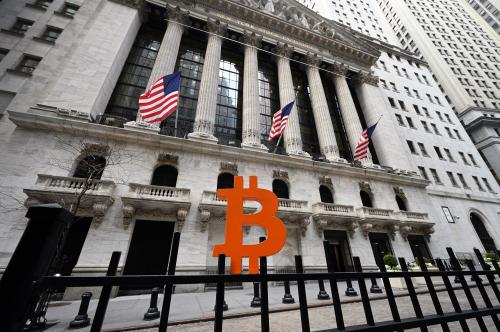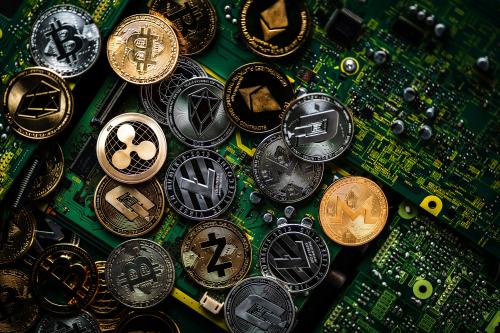A version of this review will also be published by NABE Journal is Business Economics.
Trust has long been the cornerstone of finance. Depositors trust banks to have their money, policyholders trust insurers to pay claims, lenders trust borrowers to pay them back, and traders trust counterparties to make good on deals. Historically, this trust was best achieved through intermediary financial institutions operating under substantial government regulation. New technologies such as blockchain and cryptocurrencies have given rise to an alternative model that promises trust through the substitution of algorithms and protocols for financial institutions and governments. Is this new system of decentralized finance, known as DeFi, the future of finance?
Harvey Campbell, Ashwin Ramachandran, and Joey Santoro clearly believe so, and their book DeFi and the Future of Finance starts with that premise. The book begins with a brief explanation of several problems of the current financial system which they believe are better addressed through an alternative DeFi system. The book then turns to a useful explanation of various terms commonly thrown around in the crypto world. This is the book’s best part, as anyone interested in learning the basics to more advanced elements of DeFi can quickly go through the various concepts, helpfully organized in a manner that build upon each other, and learn not only the new jargon but also what it means.
The book focuses on applications of DeFi, almost exclusively through one of the largest cryptocurrencies, the Ethereum chain. The book somewhat dismisses the more famous Bitcoin blockchain, arguing that Bitcoin functions “almost exclusively as a payment network.” Realization of the full potential of DeFi requires a “smart contract platform” of which Ethereum “is the primary example.” This argument builds on Buterin’s 2014 Ethereum white paper,1 and the book’s main sections are devoted to explaining how various smart contracts work on Ethereum, ranging from basic ownership tokenization, savings and borrowing, and derivates and synthetics.
Appreciating the ability of DeFi to replicate existing financial contracts is useful. The book argues that DeFi versions are improvements over the status quo, reducing or eliminating various types of risk, including counterparty, collateral, and execution. Among the authors’ stronger examples of ways in which DeFi can unlock new opportunities are those of tokenization of ownership and creating liquidity for illiquid assets.
Tokenization and liquidity are intertwined and solved together through the creation of fractional ownership of an asset and the ability for that ownership to be liquified. Examples include stocks, collectibles, and real estate. The book explains how DeFi technology allows faster, cheaper, and more secure transactions, with an emphasis on both the technology used and mention of some of the current larger providers. These examples give a glimpse of the promise of DeFi with clear real-world examples.
However, in many other areas, the book focuses more on the means of DeFi than the ends. At its core finance is a means. Financial systems are means that allow investors and borrowers, buyers and sellers, and traders to exchange in mutually beneficial methods. Finance is not an end: The purpose of finance is not finance. Too often the book loses that thread.
Many of the examples in this book focus on how to use one set of crypto assets to speculate on the value of other crypto assets rather than replacing a traditional usage of finance that is not speculative. The book’s examples could have been used as evidence in a BIS paper which concluded that at present there are “few real-economy uses” and instead DeFi mostly “supports speculation and arbitrage across multiple crypto assets”.2 Even more critical is Allen’s Driverless Finance,3 which argues that DeFi and crypto are, at their core, instruments of speculation, not tools for a revolution in finance. After reading DeFi and the Future of Finance, I was more supportive of Allen’s argument than before.
The book was written and published before the so-called ‘crypto winter’ in 2022 that culminated in the collapse of FTX, then the world’s second-largest crypto exchange. Ironically, the middle of the book includes a description of initial DeFi offerings that mirror one of the main aspects of how FTX built a supposedly valuable company through the issuance of its own token, FTT.4 By creating a large number of FTT tokens, releasing a small amount, and combining price manipulation with crypto speculatory enthusiasm, FTX was able to see the price of FTT rise. FTX then pledged its private FTT tokens as collateral to speculate on other investments through its affiliate Alameda. These smoke and mirrors eventually collapsed and the decline in FTT’s value helped expose other frauds within FTX.
Perhaps if the authors had the benefit of witnessing the implosion of FTX they may have revised their enthusiasm for this type of price manipulation, which they acknowledge “sets an artificial price floor of the token if the user controls the supply,” they would have had second thoughts about stating that the average consumer can rely on “the wisdom of the crowd to feel secure.” The author’s conclusion that “Overall DeFi mitigates counterparty risk and thus creates a host of efficiencies not present under traditional finance” hardly holds up given the experience of FTX.
The collapse of Silicon Valley Bank (SVB) is another episode that might have influenced the authors’ thinking. On the one hand, SVB demonstrated weaknesses in traditional finance. On the other, SVB’s relationship with one of the largest stablecoin issuers, Circle, threatened the peg of its stablecoin (USDC) to the dollar. USDC fell from $1.00 down to as low as $0.88 during the weekend when it was unclear whether uninsured depositors at SVB were going to be bailed out (in the end they were).5 “DeFi and the Future of Finance” discussed the role of USDC in smart contracts on the Ethereum chain. One wonders what would have happened to those smart contracts had USDC or any other stablecoin been subject to a run.
DeFi’s future may still be as bright as the authors anticipate. After all, the Dow Jones did eventually break 36,000 as Hassett and Glassman predicted in their 1999 book Dow 36,0006–it just took twenty two years longer than they said it would. However, for DeFi to become the future of finance, a series of legal, regulatory, and structural problems must still be addressed. The book fails to address those problems, too often asserting the problem and stopping short of explaining the mechanism by which DeFi will solve it.
One such structural issue is the question of what types of investments should be allowable to different types of investors. America’s legal and regulatory regime has been based on the principle that certain types of investments that have fewer public disclosures and generally carry greater risk are restricted to wealthy, accredited investors.7 The book treats limited access as a problem unique to traditional finance and discusses how DeFi solves that problem by allowing anyone who is interested to make these types of investments. The book does a good job of explaining the different types of smart contracts, platforms currently offering these opportunities, and details of how DeFi results in self-executing trades without counterparty risk. However, it does not address the principle behind the current restrictions nor the ramifications of their removal. Given the millions of Americans who lost money in FTX and other under-regulated crypto exchanges and assets, proponents of DeFi have to make the case as to what levels of investor protection are appropriate for retail investors in crypto and how these will rules be enforced.
Another example of that same problem is the tension between anonymity and anti-money laundering (AML). The authors note the anonymity of crypto and give the impression that this is one of DeFi’s benefits. Proof of identity is a major obstacle for many to access the financial system8 so its removal would expand access. However, America, like most countries in the world, has made foundational policy choices against anonymous finance. Policy goals ranging from stopping terrorist finance to tax evasion rely on AML requirements to identify and track the flow of funds.9 The book would be stronger if the authors acknowledged these requirements and addressed at some level how DeFi either could comply with these laws or whether DeFi is so unstoppable that it will require a rethink of the existing AML system. Instead, the authors only spend a few pages on this problem, mostly identifying the risk to DeFi platforms from regulators enforcing AML laws.
If DeFi is to become the future of finance, the AML issue will have to be resolved. Broad debate exists on the costs and benefits of the existing AML system,10 but generally speaking, there is a substantial consensus against financing terrorism, human trafficking, and other large-scale criminal enterprises. DeFi, fairly or unfairly, has suffered reputationally from association with these types of activities, an issue the book largely avoids.
The Brookings Institution is financed through the support of a diverse array of foundations, corporations, governments, individuals, as well as an endowment. A list of donors can be found in our annual reports published online here. The findings, interpretations, and conclusions in this report are solely those of its author(s) and are not influenced by any donation.
-
Acknowledgements and disclosures
The author would like to thank Andrew Zuo for his excellent contributions to this piece.
-
Footnotes
- Buterin, Vitalik. 2014. Ethereum: A Next Generation Smart Contract and Decentralized Application Platform. https://ethereum.org/en/whitepaper/.
- Aramonte, Sirio, Wenqian Huang, and Andreas Schrimpf. 2021. DeFi Risks and the Decentralisation Illusion. BIS Quarterly Review: 21–36. https://www.bis.org/publ/qtrpdf/r_qt2112b.pdf.
- Allen, Hilary J. 2022. Driverless Finance: Fintech’s Impact on Financial Stability. New York, NY: Oxford University Press. https://doi.org/10.1093/oso/9780197626801.001.0001.
- Gura, David. 2022. FTX Made a Cryptocurrency That Brought in Millions. Then It Brought down the Company. National Public Radio. https://www.npr.org/2022/11/15/1136641651/ftx-bankruptcy-sam-bankman-fried-ftt-crypto-cryptocurrency-binance.
- Reuters. 2023. Stablecoin USDC breaks dollar peg after revealing $3.3 billion Silicon Valley Bank exposure. March 11. https://www.cnn.com/2023/03/11/business/stablecoin-circle-silicon-valley-bank/index.html#:~:text=USDC’s%20price%20usually%20holds%20close,hedge%20fund%20Three%20Arrows%20Capital.
- Glassman, James K., and Kevin A. Hassett. 2000. Dow 36,000 : The New Strategy for Profiting from the Coming Rise in the Stock Market. 1st pbk. ed. New York: Three Rivers Press.
- Zimmerman, Christopher R. 2019. Accredited Investors: A Need for Increased Protection in Private Offerings. Northwestern University Law Review 114, no. 2: 507–538. https://heinonline.org/HOL/P?h=hein.journals/illlr114&i=519.
- Claessens, Stijn. 2006. Access to Financial Services: A Review of the Issues and Public Policy Objectives. World Bank Research Observer 21, no. 2: 207–240. http://hdl.handle.net/10986/16428.
- Bank Secrecy Act of 1970, 31 U.S.C §1951 et seq.
- Bank Policy Institute (BPI). 2018. Getting to Effectiveness – Report on U.S. Financial Institution Resources Devoted to BSA/AML & Sanctions Compliance. BPI AML, Bank Secrecy Act and Sanctions Reports and Research Notes. https://bpi.com/getting-to-effectiveness-report-on-u-s-financial-institution-resources-devoted-to-bsa-aml-sanctions-compliance/.






